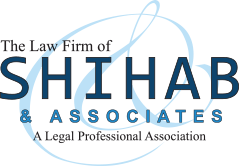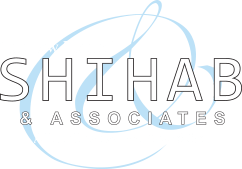U.S. employers who wish to permanently employ a foreign worker with an advanced degree (above a U.S. baccalaureate level of education or its foreign equivalent) may file an immigrant petition to classify the foreign worker under the second preference employment-based (EB-2) immigrant visa category. When petitioning for a foreign worker under EB-2, the U.S. employer typically must include a labor certification. The labor certification confirms that there are no qualified U.S. workers available, that the foreign national will be paid the prevailing wage, and that hiring the foreign national will not adversely affect the U.S. workforce. In addition to the labor certification, the petitioner must provide evidence that the proffered position requires an advanced degree or special skill and that the foreign national is qualified for the proffered position.
At the Law Firm of Shihab & Associates, we have decades of combined immigration experience. Please contact us today for a consultation and experience proven results through innovating representation.
Six Year Rule and BeyondUSCIS, particularly the Nebraska Service Center, once rigidly followed a relatively obscure and unwritten policy, known as the “Six Year Rule,” which required that a beneficiary attain six cumulative years of academic education in order to qualify under the “advanced degree” requirement. In other words, a beneficiary who has attained a 3-year baccalaureate level of education in addition to attaining a 3-year master’s degree may qualify under the advanced degree requirement. However, if the beneficiary attained a 3-year bachelor’s degree and completed a 2-year master’s program, then that beneficiary did not qualify as holding an advanced degree. This unsupported policy resulted in numerous denials of EB-2 petitions as several foreign universities offer 3-year bachelor’s programs rather than the 4-year bachelor’s programs typically found in the U.S. In 2008, in an unpublished decision, the Administrative Appeals Office (AAO) determined that if a credible foreign academic equivalency evaluator determines that the beneficiary has attained the equivalent of a U.S. master’s degree, it is not relevant whether the bachelor’s degree was attained in a 3 year or 4 year program. Welcomed with open arms, this decision reduced the petitioners’ burdens from proving that the beneficiary possess both the equivalent of a U.S. bachelor’s degree in addition to the U.S. equivalent to a U.S. master’s degree down to only being required to prove that the beneficiary possesses the U.S. equivalent to a U.S. master’s degree, regardless of whether the beneficiary has attained the equivalent to a U.S. bachelor’s degree.
However, petitioners must continue to be clear about the acceptable educational requirements when filing the labor certification. Indicating only that a U.S. master’s degree or its equivalent is required would likely result in a denial of the petition because, although the AAO has stated that it is sufficient to prove only that a beneficiary has attained the equivalent to a U.S. master’s degree, EB-2 petitions are still being denied if petitioners require a master’s degree or its equivalent, but do not indicate that they will accept an alternative combination of experience than the traditional 4 year bachelor’s degree or the Six Year Rule approach. Instead, petitioners must clearly indicate in Section H of the labor certification that an alternative combination of education is accepted.
Click here to read our blog article pertaining to this exact issue specifically for Indian nationals.
In fact, a recent AAO decision highlights the importance of clear drafting of the labor certification, in addition to providing some general points to remember when submitting an EB-2 petition based on an advanced degree.
Considerations for Filing a Labor CertificationUnder 8 C.F.R. § 204.5(k), the beneficiary of an EB-2 petition must have an advanced degree above a bachelor’s degree or the foreign equivalent. In order to prove that a beneficiary meets this requirement, petitioners must submit evidence that the beneficiary has attained an advanced U.S. degree or a foreign equivalent degree. Finally, petitioners must include in Section H of the labor certification that the position requires no less than an advanced U.S. degree or the foreign equivalent to an advanced U.S degree. It is here that many issues arise.
In the AAO decision, the petitioner, an IT service business, sought to permanently employ the beneficiary as a systems software developer by petitioning to classify the beneficiary as an advanced degree professional under the EB-2 immigrant visa program. However, the director denied the petition based on the opinion that a labor certification does not require a member of the professionals holding an advanced degree. The director determined that the labor certification did not support an EB-2 classification because it “would allow for the combination of education, experience, and/or training to be ‘equivalent’ to a master’s degree. The director based this determination on the fact that the petitioner reported on the labor certification that a Master’s degree in Computer Science or Information Systems, or related field was required, but indicated in Section H.8 that an alternate combination of education and experience would be accepted. The petitioner added in Section H.8B that the alternative level of education accepted was “Education evaluated to a Master’s.” In addition, the petitioner indicated in Section H.8C that zero (0) years of experience would be acceptable to fulfill its answer in Section H.8.
This case presents a clear example of the USCIS attempting to apply the Six Year Rule and a petitioner’s clever drafting of the labor certification. By indicating that the petitioner requires a master’s degree, but that it would accept education evaluated to the equivalent of a master’s degree, the petitioner perfectly met the requirement that the position require an advanced degree and made clear that the beneficiary need only possess the equivalent of a U.S. master’s degree, not the equivalent of a U.S. bachelor’s degree and a U.S. master’s degree.
Drafting the labor certification in this manner is essential when petitioning for a beneficiary who has obtained a 3-year foreign bachelor’s degree and an advanced degree because it obliterates the Six Year Rule and still meets the regulatory requirements.
Considerations for Submitting Academic Equivalency EvaluationsAfter withdrawing the director’s denial based on the issue of an acceptable alternative combination of education and experience, the AAO questioned whether the beneficiary was actually qualified for the position. The petitioner reported on the labor certification that the minimum qualification for the position was a master’s degree, or its equivalent, in Computer Science, Information Systems, or related field.
The beneficiary obtained a Master of Computer Application degree from a foreign university in India. Along with the beneficiary’s transcripts and diploma, the petitioner submitted a foreign equivalency evaluation completed, by an evaluator at International Credentials Evaluation and Translation Services, which concluded that the beneficiary had obtained the foreign equivalent to a Master of Science Degree in Computer Science, thereby qualifying him for the position. However, because the evaluator did not explain the basis for his evaluation, the AAO questioned whether the beneficiary was actually qualified for the position. As such, the case was sent back to the director to make this determination based on any additional evidence that the petitioner provided to clarify this issue.
Thus, when navigating around the Six Year Rule, it is important that petitioners are able to proffer sufficient evidence that the beneficiary has in fact obtained the equivalent to a U.S. master’s degree, particularly when the beneficiary has obtained a 3-year bachelor’s degree.
ConclusionThis non-binding decision of the AAO highlights some important considerations when petitioning for any employment-based visa. First, although the director’s decision was ultimately withdrawn on this issue, it is important that petitioners are clear about the required qualifications as reported on the labor certification. In determining whether to approve a petition, the USCIS directors are permitted to look only to what is reported in the labor certification. The director may not ignore any terms of the labor certification nor may the director impose additional terms. As such, unclear terms of a labor certification could result in a delay in your petition. Second, when including a foreign equivalency evaluation of a beneficiary’s academic qualifications, it is important that the evaluator includes a basis for the determination. Submitting an evaluation that is not supported by an explanation may also cause delay or even a denial of the petition as an unsubstantiated evaluation does not provide conclusive evidence of the beneficiary’s qualifications.
Contact UsPrecise and clever drafting of labor certifications can make or break your case. The Law Firm of Shihab & Associates prides itself on staying apprised of changes in immigration policy and rulings in order to ensure that your case is following the most up-to-date policies and procedures. We have handled countless PERM applications and are experienced in carefully and accurately drafting labor certifications. Contact us today to consult with one of our experienced attorneys.

